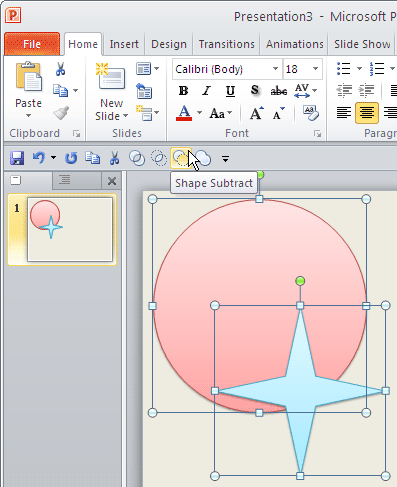Learn how you can subtract shapes in PowerPoint 2010 for Windows. The Shape Subtract command retains the first selected shape and subtracts overlapping areas of other shapes.
Author: Geetesh Bajaj
Product/Version: PowerPoint 2010 for Windows
OS: Microsoft Windows XP and higher
PowerPoint 2010 for Windows lets you change how your shapes merge with its four Combine Shape commands: Combine, Intersect, Subtract, and Union. You can end up with some seriously impressive results. In this tutorial, we'll show you how you can subtract one shape from another. For example, we placed two shapes over each other as shown towards the left of Figure 1. With these shapes selected, we could use the Shape Subtract command that we explain later in this tutorial to create a subtracted shape as shown towards the right in Figure 1.

Figure 1: Sample showing use of the Shape Subtract command
Once you finish reading this tutorial, do view the sample presentations embedded at the bottom of this page to see more samples of shapes that use the Shape Subtract command.
The Shape Subtract command is one of the four new Shape commands that are not visible by default in PowerPoint 2010 for Windows. You need to enable them as explained in Add Combine Shapes Commands to the Quick Access Toolbar (QAT) in PowerPoint 2010 for Windows. Thereafter follow these steps:


Do remember these guidelines for any tasks that involve the usage of this command. The Shape Subtract command:
You will see these guidelines in use within the embedded presentations below (scroll down this page).
The sample presentations below show how we used different shapes placed next to and above each other, and then subtracted.
Click below to view on SlideShare
Click below to view on YouTube
See Also:
Merge Shapes: Shape Subtract Command in PowerPoint (Index Page)
Shape Subtract Command in PowerPoint 2016 for WindowsYou May Also Like: Key Steps for Feedback When Someone Has Done a Dreadful Job | Light Bulb PowerPoint Templates




Microsoft and the Office logo are trademarks or registered trademarks of Microsoft Corporation in the United States and/or other countries.